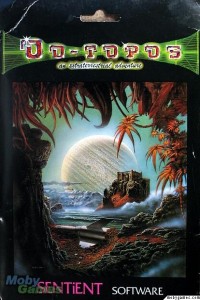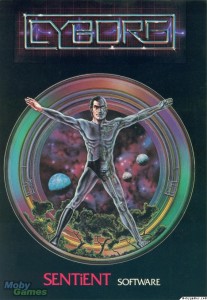In 1979 a 30-year-old aspiring science-fiction writer named Mike Berlyn bought an Apple II. He had already finished and delivered his first two novels to Bantam Paperbacks, who would release them under the titles The Crystal Phoenix and The Integrated Man the following year. Now about to start on a third, he had heard that these new PCs were going to change the way writers wrote, and was eager to find out for himself. In the long term, the prediction was of course not wrong, but Berlyn quickly found that the technology of 1979 was, as they say, not quite there yet. The Apple II didn’t even yet support lower-case letters at this point, necessitating all sorts of kludges in early word processors that took them about as far away as you can get from the ideal of what you see is what you get. He ended up writing his third novel, eventually published by Ace Paperbacks as Blight under the pen name Mark Sonders in 1981, the old-fashioned way.
Still, Berlyn was far from disappointed with his purchase. The Apple II may still have been problematic from a practical standpoint, but Berlyn, like so many before and after him, found it an endlessly fascinating toy. When not writing that third book, he spent most of his time exploring his new machine. He found text adventures particularly compelling, but was disappointed by the obvious lack of literary skill of most of the people creating them. Being an enterprising sort, Berlyn decided when the third book was finished that, rather than start right away on a fourth, he’d like to try making a text adventure or two of his own. The result of that aspiration was Sentient Software, a company founded by Berlyn and his wife Muffy with the help of some other partners also located near the Berlyns’ Colorado home. Sentient published two games in 1981, Oo-Topos and Cyborg. Both were written and programmed entirely by Berlyn with a bit of help from his wife, and both were science-fiction adventures involving a damaged spaceship.
In many ways these games are very typical of their era. Technically, they are most similar to Softporn of the games I’ve already discussed on this blog; they are built from a BASIC program with a two-word parser that fetches text and details of the storyworld as needed from data files stored on the disk. They are, in other words, about equivalent to the Scott Adams games in their parser and in the depth of their world modeling, but their use of the disk drive gives them space to be much more loquacious (certainly an important attribute for a “real” writer like Berlyn) and to have much bigger geographies. Indeed, their worlds are quite big ones, but made up mostly of empty rooms, connected via undescribed exits that necessitate painstaking mapping — and that’s outside the obligatory mazes. And of course, the parser makes many puzzles much harder than they ought to be. (Finding out what the correct verbs are, Cyborg tells us, is “half the fun.” Um, no.)
Yet in other ways these games represent something new and significant. Berlyn was the first author to come to the text adventure from the world of traditional fiction. He was interested in the form not, like the hackers who preceded him, as an interesting technical challenge, but rather as a potential new form of storytelling. The packaging of the games emphasized that they were not about “treasures” or “score,” but about “character development,” consistency, and plot. Some of those claims may have been more than a bit of a stretch, but Berlyn was trying, and that is significant in itself.
The plot of Cyborg, the more thematically audacious of the two games, casts you as, well, a cyborg, a human who has been physically and mentally merged with a robot. When play begins, you have amnesia, an adventure-game trope that would soon become a cliché but that may just see its first appearance here. Robbing your avatar of her memory allows Berlyn to place the two of you in the same mental situation. You both spend the game piecing together what brought you to this state, marooned on a stricken spaceship in orbit around a strange planet. Although you are expected to eventually repair the spaceship and lead your people — whom you eventually realize are colonists stored in suspended animation aboard the ship — to the planet below, the vast majority of the plot is not really story per se, but rather backstory, a frame to contain the game’s traditional puzzle- and mapping-oriented play. Within that frame, however, the game’s environments are indeed consistent and believable in a way that hadn’t been seen before. Like amnesia, Cyborg‘s piece-together-the-back-story approach to plotting would soon become an adventure-game cliché. Still, it became a cliché because, at least in these earlier, less jaded days, it worked. Here it allows Berlyn to present a much richer fictional experience than would normally be possible given the primitive technology on-hand to him. His use of it marks him as — and I don’t use this word lightly — a visionary, someone thinking about the medium’s potential in a very progressive way.
One of the most interesting aspects of Cyborg is its handling of the player / avatar split. You play a disembodied human intelligence who must communicate with another, synthetic entity to accomplish absolutely everything. The idea of a split or disembodied consciousness was one that Berlyn found endlessly intriguing; his first two novels both dealt with similar themes, and he would return to it yet again (and most famously) in his next game, Infocom’s Suspended. Here he gets huge mileage out of his concept, including using it to account for the limitations of his parser:
I MAY NOT SEEM VERY HELPFUL AT TIMES BUT I DO WHAT I CAN. MY VOCABULARY IS PRETTY LARGE CONSIDERING THE STATE MY CHIPS ARE IN. THE CIRCUITS USED TO MAKE LOGICAL DECISIONS AND CARRY OUT ORDERS ARE DIFFERENT THAN THOSE USED TO DESCRIBE LOCATIONS. I TELL YOU THIS SO YOU WILL UNDERSTAND THAT ALTHOUGH I MAY USE A WORD IN ONE SENSE THAT DOESN’T MEAN I’LL UNDERSTAND IT IN ALL CASES. IT WILL HELP US BOTH IF YOU ARE AS SPECIFIC AS POSSIBLE WHEN COMMUNICATING WITH ME. AVOID WORDS LIKE “USE” OR “CONTINUE.” IF YOU WANT TO DO SOMETHING I SAY WE CAN’T TRY A SIMILAR VERB.
The game’s simple hint system is likewise integrated into the fiction. You can ask your computerized companion what he thinks about locations or items, and occasionally — very occasionally — will get a helpful suggestion.
This unusual concept makes Cyborg one of the few (only?) text adventures ever written in the first-person plural. And again, it’s reflective of some unusually sophisticated thinking about the medium and its possibilities. Scott Adams and others had previously described the player’s avatar as her “puppet,” and at times seemed to give it a separate consciousness, at least if we can judge from the occasional snappy comebacks it gave to nonsensical or dangerous inputs. But no one had previously devised a scenario where even parser frustrations fitted into the scenario so seamlessly. Cyborg marks the first of a long line of games — and almost as many articles in game theory — to explicitly, consciously (ha!) play with the identities of player and avatar. Berlyn even extends the conceit to the verbs permitted. For instance, you cannot LOOK but must SCAN, and an INVENTORY becomes a BODY SCAN.
Given their obviously limited resources, Berlyn and company did the best they could marketing Oo-Topos and Cyborg. For packaging they used a very minimalist cardboard folder, but did commission some nice science-fiction art for the covers.
Still, and as Chuck Benton was discovering at about the same time, it was getting harder for the bedroom hacker without connections to distributors and the like to get his software into stores. Cyborg received an absolutely glowing review in the influential Softalk magazine: “Cyborg introduces the most exciting advances in adventuring since the original Adventure began the whole wonderful thing.” Yet even that wasn’t enough to overcome Sentient’s distributional problems and make the game a success.
Berlyn designed a couple more games for Sentient in 1982, albeit less ambitious arcade-oriented fare, called Gold Rush and Congo. They similarly didn’t make much of an impact. At this point Berlyn and his partners had some sort of falling out which led him to walk away from the company. Over the next couple of years, said partners funded ports of Berlyn’s adventures to the Atari 400 and 800, the IBM PC, and the Commodore 64, before allowing Sentient to fade quietly out of existence. Berlyn, however, was just getting started in interactive fiction, as we’ll see in later posts.
Cyborg is as fascinating conceptually as it can be frustrating to actually play, but it’s well worth a look by any student of the art of interactive fiction. I’ve therefore made the Apple II disk image available for you.
Next time: we’ll take our first tentative steps across the big pond.











